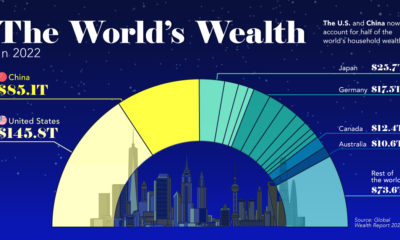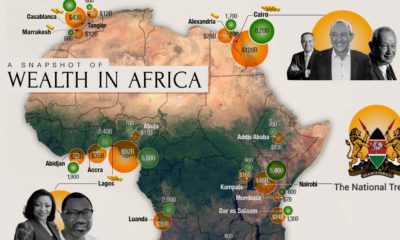We’ve previously looked at how the architectural feats of humanity have simply grown in magnitude over time, tracing this progress as far back as the Stone Age. The question now is, how much higher and further into the skies can we reach? This infographic by Alan’s Factory Outlet looks at the glittering urban skyscrapers on every continent. We also examine some interesting facts about each region.
Asia: Growing Ever Upwards
The first name on this list certainly needs no introduction. Dubai’s Burj Khalifa is one of the most popular tourist attractions in the Middle East. With just a one minute elevator ride to the Burj Khalifa’s pinnacle, it must seem like even the sky is no longer the limit. Ping An Finance Center from Shenzhen edges into fifth place on the list, and it’s worth mentioning the speed of change occurring in the city. China’s hi-tech capital will see the completed construction of approximately 51 buildings over 145m (476ft) by the end of 2020.
North America: Concrete Jungle
The One World Trade Center, built to memorialize the loss of the Twin Towers after September 11th, 2001, is also informally called the “Freedom Tower”. It’s exactly 1,776ft high—symbolizing the year the U.S. Declaration of Independence was adopted. While the Central Park Tower has reached its full height, parts of the interior are still undergoing construction. The price of luxury apartments in the complex start at $7 million for a two-bedroom, just in case you had any extra change lying around. In fact, the illustrious New York City holds four of the top five buildings on the continent. However, a nod also goes to the Willis Tower (formerly Sears Tower) in Chicago, an imposing office building which held the title of world’s tallest building for 25 years, until the Petronas Towers were erected in Kuala Lumpur.
Europe: Russia’s Reign
The top five tallest buildings in Europe can all be found in Russia. What’s more, those from Moscow are all clustered within a single towering business district known as “Moscow-City”. This begs the question—why doesn’t Europe build more skyscrapers? There’s an interesting historical reasoning behind this. As North America’s new age ideals and influence on the world stage grew, European cultural values focused on preserving heritage. Of course, with globalization, things have changed somewhat, and major financial centers of London, Paris and more boast unique skylines of their own.
Oceania: The Views Down Under
Australia’s buildings unsurprisingly dominate the tallest ones in the region. In the surfer’s paradise, Q1 on the Gold Coast has a twist in its design—literally. Its architecture is loosely based on studies of ribbons moving in the wind, as they wrap around the tower. The Eureka Tower has a fascinating story behind it, too. It’s named after the 1854 Victorian gold rush, with elements of the building reflecting this history—from a gold crown to a red stripe for revolutionary bloodshed.
South America: Views From the Top
The tallest buildings in South America are mainly residential, and often found in Brazil, Argentina, and Venezuela—but Chile is the one standout exception to this rule. Gran Torre Santiago is a retail and office complex, and the largest shopping mall across Latin America. It’s often considered the heart of Chile, and built to hold its ground steadfastly in the earthquake-prone country.
Africa: Budding Buildings
Located in South Africa’s largest city, The Leonardo is the jewel of Johannesburg. The tallest building in Africa was also designed by an architectural team of mostly women. For African nations, these tallest buildings mean much more than just breaking engineering records. In a journal article, it’s posited that skyscrapers can act as a symbol of power and the continent’s drive towards modernity.
Future Superstar Skyscrapers
A few more mammoth buildings are expected to rise up in the next couple years. Saudi Arabia’s 167-floor Jeddah Tower, while currently on hold, could someday take over the first place crown. Meanwhile, Dubai’s set to outdo itself—and compete directly with Saudi Arabia. The Kingdom Tower is inspired by the Hanging Gardens of Babylon, and is proposed to break the 1 kilometer-high (or 0.6 mile) mark not yet achieved by any building. Who knows what greater heights we could scale this century? —Adrienne Clarkson, Former Governor General of Canada on Even while political regimes across these countries have changed over time, they’ve largely followed a few different types of governance. Today, every country can ultimately be classified into just nine broad forms of government systems. This map by Truman Du uses information from Wikipedia to map the government systems that rule the world today.
Countries By Type of Government
It’s important to note that this map charts government systems according to each country’s legal framework. Many countries have constitutions stating their de jure or legally recognized system of government, but their de facto or realized form of governance may be quite different. Here is a list of the stated government system of UN member states and observers as of January 2023: Let’s take a closer look at some of these systems.
Monarchies
Brought back into the spotlight after the death of Queen Elizabeth II of England in September 2022, this form of government has a single ruler. They carry titles from king and queen to sultan or emperor, and their government systems can be further divided into three modern types: constitutional, semi-constitutional, and absolute. A constitutional monarchy sees the monarch act as head of state within the parameters of a constitution, giving them little to no real power. For example, King Charles III is the head of 15 Commonwealth nations including Canada and Australia. However, each has their own head of government. On the other hand, a semi-constitutional monarchy lets the monarch or ruling royal family retain substantial political powers, as is the case in Jordan and Morocco. However, their monarchs still rule the country according to a democratic constitution and in concert with other institutions. Finally, an absolute monarchy is most like the monarchies of old, where the ruler has full power over governance, with modern examples including Saudi Arabia and Vatican City.
Republics
Unlike monarchies, the people hold the power in a republic government system, directly electing representatives to form government. Again, there are multiple types of modern republic governments: presidential, semi-presidential, and parliamentary. The presidential republic could be considered a direct progression from monarchies. This system has a strong and independent chief executive with extensive powers when it comes to domestic affairs and foreign policy. An example of this is the United States, where the President is both the head of state and the head of government. In a semi-presidential republic, the president is the head of state and has some executive powers that are independent of the legislature. However, the prime minister (or chancellor or equivalent title) is the head of government, responsible to the legislature along with the cabinet. Russia is a classic example of this type of government. The last type of republic system is parliamentary. In this system, the president is a figurehead, while the head of government holds real power and is validated by and accountable to the parliament. This type of system can be seen in Germany, Italy, and India and is akin to constitutional monarchies. It’s also important to point out that some parliamentary republic systems operate slightly differently. For example in South Africa, the president is both the head of state and government, but is elected directly by the legislature. This leaves them (and their ministries) potentially subject to parliamentary confidence.
One-Party State
Many of the systems above involve multiple political parties vying to rule and govern their respective countries. In a one-party state, also called a single-party state or single-party system, only one political party has the right to form government. All other political parties are either outlawed or only allowed limited participation in elections. In this system, a country’s head of state and head of government can be executive or ceremonial but political power is constitutionally linked to a single political movement. China is the most well-known example of this government system, with the General Secretary of the Communist Party of China ruling as the de facto leader since 1989.
Provisional
The final form of government is a provisional government formed as an interim or transitional government. In this system, an emergency governmental body is created to manage political transitions after the collapse of a government, or when a new state is formed. Often these evolve into fully constitutionalized systems, but sometimes they hold power for longer than expected. Some examples of countries that are considered provisional include Libya, Burkina Faso, and Chad.













